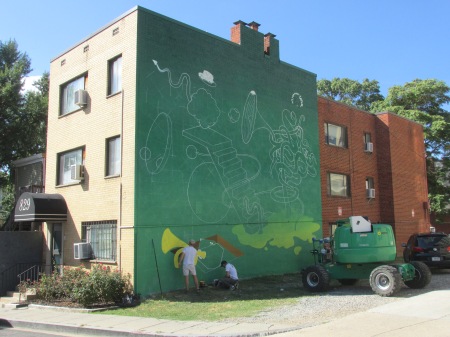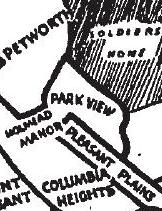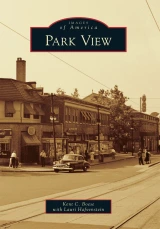
Commuters depicted in the mural at the Georgia Avenue Metro station.
With Metro’s current focus on repairing and upgrading the Metrorail system — and the disruption it is causing for daily commuters — it might be easy to overlook some of the things Metro has done well. One example that I appreciate every day is the mural at the Georgia Avenue-Petworth Station titled Homage to a Community.
The following description of the mural is from WMATA’s Web site,
Homage to a Community, by Florida artists Andrew Reid and Carlos Alves, is located at Georgia Avenue-Petworth station on the Green Line in the District of Columbia. The artwork consists of two components. The 130-foot-long stylized painted mural by Andrew Reid illustrates the rich history of the Georgia Avenue-Petworth community. The bold design of the contoured mural is a flowing chronology of defining events in the George Avenue-Petworth community in the context of local and world histories. The high energy of the handmade clay and cracked tiles of the accompanying frieze by Carlos Alves captures the spirit and promise of the Georgia Avenue-Petworth community.
In 2015, the Georgia Avenue station served about 6,300 daily riders. That’s a lot of people walking past the mural every day — yet I suspect few pay much attention to the mural and possibly fewer still take time to appreciate some of the imagery and how it relates to the community. In looking at the images, the mural largely shows a history of Georgia Avenue south of the Metro station and reads from right to left.
Among the images are references to Native Americans; Abraham Lincoln, the civil war, & the emancipation proclamation; Schuetzen Park; Howard University; Griffith Stadium and the Senators & Grays; the Bakeries of lower Georgia Avenue, such as Corby and Bond Bread; Duke Ellington and U Street; World War II; Civil Rights; and modern commuters.
Below are a few images from the mural:
 (Native Americans are depicted at the beginning of the mural as one enters the station from the west side. One of D.C.’s oldest continuous streets is Rock Creek Church Road, which likely started at a trail blazed by Native Americans.)
(Native Americans are depicted at the beginning of the mural as one enters the station from the west side. One of D.C.’s oldest continuous streets is Rock Creek Church Road, which likely started at a trail blazed by Native Americans.)
 (Abraham Lincoln is prominently included in the mural. Lincoln summered at the nearby Soldiers’ Home and would travel on Rock Creek Church Road and Georgia Avenue on his daily commute to the White House.)
(Abraham Lincoln is prominently included in the mural. Lincoln summered at the nearby Soldiers’ Home and would travel on Rock Creek Church Road and Georgia Avenue on his daily commute to the White House.)
 (Germans drinking and shooting game refer to the old Schuetzen Park, located near Georgia Avenue and Irving Street.)
(Germans drinking and shooting game refer to the old Schuetzen Park, located near Georgia Avenue and Irving Street.)
 (Baseball at Griffith Stadium — located where Howard University Hospital now sits — is represented by this section of the mural.)
(Baseball at Griffith Stadium — located where Howard University Hospital now sits — is represented by this section of the mural.)
 (The once active bakeries of southern Georgia Avenue are shown above. The section also includes a streetcar.)
(The once active bakeries of southern Georgia Avenue are shown above. The section also includes a streetcar.)
 (Duke Ellington and the vibrant U Street community are depicted above.)
(Duke Ellington and the vibrant U Street community are depicted above.)
 (Artist Maryanne Pollock is working to create tent murals at Wangari Gardens.)
(Artist Maryanne Pollock is working to create tent murals at Wangari Gardens.) (Pollock’s tent murals have already be part of successful community art projects in Maryland, Delaware, and Scotland.)
(Pollock’s tent murals have already be part of successful community art projects in Maryland, Delaware, and Scotland.) (Preliminary design of mural for the Ward 1 senior wellness center by artist Jay Coleman.0
(Preliminary design of mural for the Ward 1 senior wellness center by artist Jay Coleman.0

 (Philippa Hughes at the SEE/CHANGE kickoff at Tchoup (3301 Georgia Avenue))
(Philippa Hughes at the SEE/CHANGE kickoff at Tchoup (3301 Georgia Avenue))





 (Design by Remi Rough for 649 Kenyon Street)
(Design by Remi Rough for 649 Kenyon Street)






 "The territory comprising Park View extends from Gresham Street north to Rock Creek Church Road, and from Georgia Avenue to the Soldiers' Home grounds, including the triangle bounded by Park Road, Georgia Avenue, and New Hampshire Avenue" (from Directory and History of Park View, 1921.)
"The territory comprising Park View extends from Gresham Street north to Rock Creek Church Road, and from Georgia Avenue to the Soldiers' Home grounds, including the triangle bounded by Park Road, Georgia Avenue, and New Hampshire Avenue" (from Directory and History of Park View, 1921.)

Interactive Art Installation Explores Human Behavior on City Streets
January 24, 2017There is currently a public art exhibit on the corner of 14th and U streets in front of the Reeves Center. It is titled The Walkway and it is an interactive installation that is an exploration of human behavior towards others on city streets and in public spaces. The art space consists of a tunnel with each side showing faces and statements of interactions that have been experienced in public. Some of the experiences shared are positive — others are negative, harassing, or hostile.
What I like about the experience is that it makes one reflect upon their own experiences and interactions in public spaces. There is also an online component which allows anyone to participate in the project, which is a collaboration between the D.C. Commission on the Arts and Humanities and the District Department of Transportation. Through the portal, they are collecting information regarding words, phrases and gestures that are used in public spaces to address others. This is a study to explore what people consider to be respectful, friendly, non-friendly or threatening interactions. While data collected will be used as part of an interactive exhibit, responses will be kept anonymous.
Below are a few more photos from my visit:
Share this:
Categories: Art
Tags: Art, public art, social commentary
Comments: Be the first to comment